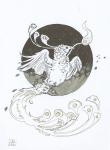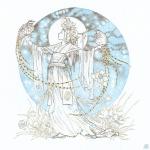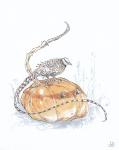Galleries : Undying Tales 2021 : UT 9 - Reeves Pheasant
|
ORIGINALS:
Syrmaticus reevesii Status: Vulnerable - habitat loss and overhunting for their tail plumes The Luan bird is one of the celestial birds of Chinese mythology, and akin to the Feng bird (phoenix). In bestiaries and poetry, it is described with the form of a pheasant with five-colored markings, and if sighted, is an omen of good fortune and prosperity. It can be found roosting in the branches of paulownia trees, and its voice is bell-like and harmonious. A poem written in the 4th century by official Fan Tai told of a King of Jibin who caught a Luan. He wanted very much to hear it sing, but despite his coddling and fondness, while held captive in a cage it grew despondent and would not utter a peep. His wife suggested that perhaps it was because it needed to see another of its kind. The King had a mirror placed by the cage, and when the Luan caught sight of its own reflection, it uttered the most mournful of cries and then died. Other legends tell of the Luan as the mount for mortals who are transcending into a divine state, and as the mode of transport for the Queen Mother of the West, queen of immortals. Source: Hargett, James M. “Playing Second Fiddle: The Luan-Bird in Early and Medieval Chinese Literature.” T'oung Pao, vol. 75, no. 4/5, 1989, pp. 235–262. JSTOR, www.jstor.org/stable/4528455. Accessed 12 Aug. 2021.
Size: 7 x 7 inches Detail closeups:
|





